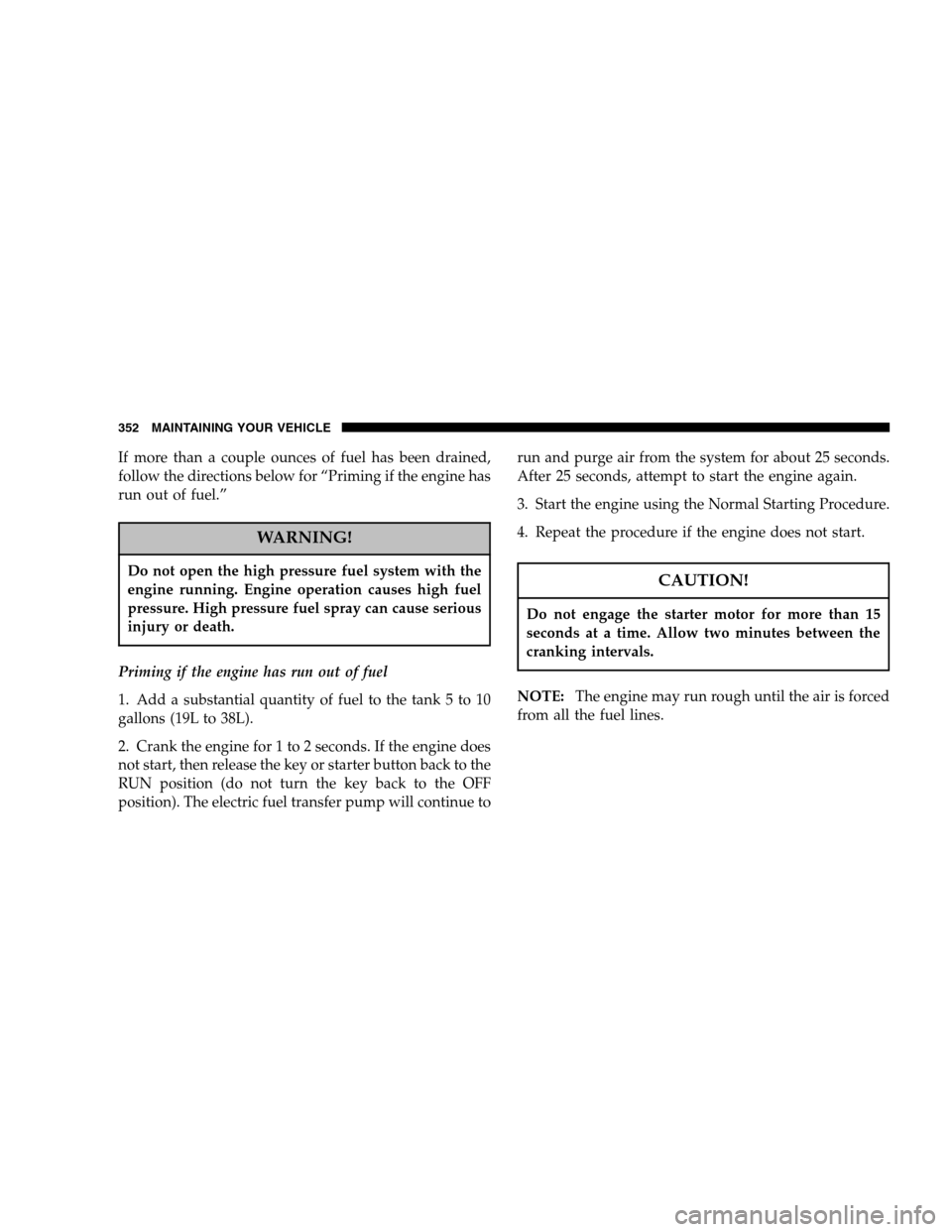Page 347 of 448

CAUTION!
The filtering medium of other aftermarket filters
may disintegrate. Debris from failed filters may plug
the piston oil cooling nozzles, resulting in scuffed
pistons and engine failure.
CAUTION!
Fill the oil filter element with clean oil before
installation. Use the same type oil that will be used
in the engine. When filling the oil filter, prevent
foreign material from falling into the filter. Severe
engine damage may occur.
Apply a light film of lubricating oil to the sealing surface
of the filter gasket before installing the filter.
CAUTION!
Overtightening may distort the threads or damage
the filter element seal.
Install the filter as specified by the filter manufacturer.
Turn the filter 3/4 to one full turn after making contact
with the gasket.
Check the condition of the threads and sealing surface on
the oil pan and drain plug.
Install the drain plug and sealing washer and tighten to
37 ft-lbs. (50 N·m).
Use only high-quality multi-grade lubricating oil in your
Cummins Diesel Engine. Choose the correct oil for your
operating conditions as outlined in the Selection of
Engine Oil.
MAINTAINING YOUR VEHICLE 347
7
Page 348 of 448

Cummins Turbo Diesel
Fill the engine with the correct grade of new oil. The
engine capacity is 11 quarts (10.4 liters) in the crankcase
and 1 quart (.95 liter) in the lubricating oil filter.
Start the engine and operate it at idle for several minutes.
Check for leaks at the lubricating oil filter and oil pan
drain plug.
Run the engine until it has reached operating tempera-
ture, stop the engine. Wait approximately 15 minutes to
let the oil in the upper parts of the engine drain back to
the pan. Check the oil level again.
Add oil as necessary to bring the level to the “SAFE”
mark on the dipstick.
Disposing Of Used Engine Oil And Filter
Care should be taken in disposing of the used engine
fluids from your vehicle. Used fluids, indiscriminately
discarded, can present a problem to the environment.Contact your local dealer, service station, or governmen-
tal agency for advice on recycling programs and where
used fluids and filters can be safely discarded in your
area.
Drive Belt
Inspection
Check the belt for intersecting cracks.
•Transverse (across the belt width) cracks are accept-
able.
•Longitudinal (direction of belt length) cracks that
intersect with transverse cracks are NOT acceptable.
Replace the belt if it has unacceptable cracks, is frayed or
has pieces of material missing.
The engine speed sensor, located near the damper, should
be inspected for damage if a belt is frayed.
348 MAINTAINING YOUR VEHICLE
Page 349 of 448
Engine Air Cleaner Filter
CAUTION!
All air entering the engine intake must be filtered.
The abrasive particles in unfiltered air will cause
rapid wear to engine components.
The air filter housing on your Diesel Ram is equipped
with a Filter Minder™. This is an air flow restriction
gauge that will indicate when the filter element needs to
be replaced.
Do not remove the top of the air filter housing to
inspect the filter element on your diesel engine under
normal operating conditions.The clear plastic housing on the Filter Minder™ allows
you to view the amount of air pressure drop across the
filter element. It consists of a diaphragm and a calibrated
spring sealed inside the plastic housing. As the air
cleaner filter becomes clogged and air pressure drop
MAINTAINING YOUR VEHICLE 349
7
Page 350 of 448

across the filter element increases, a yellow disc travels
along a graduated scale on the side of the Filter
Minder™.
The yellow disc will always show the greatest restriction
experienced by the filter element. When the disc reaches
the red zone, the filter element may need to be replaced.
There is no other time or mileage interval for changing
the air cleaner filter element.
If the vehicle experiences a sudden loss of engine power
when being driven in heavy snow or rain or when
plowing snow, check the Filter Minder™
•If the Filter Minder™ is showing a plugged filter, the
filter should be visually inspected for snow/ice build
up or extreme water saturation.
•The filter is not damaged, remove all snow/ice, rein-
stall filter and reset the Filter Minder™.A visual inspection of the air cleaner filter element is
never recommended under normal circumstances. A
badly restricted element may appear clean while a soiled
element may be quite effective in filtering particles
without restricting air flow. Rely on the Filter Minder™
to determine when a filter change is necessary.
After a new filter element is inserted, press the rubber
button on the top of the Filter Minder™. This action will
reset the yellow disc to the clean position.
CAUTION!
When using an engine cleaner or a degreaser, be sure
to wrap and tape the Filter Minder™ to protect the
plastic housing from damage and discoloration.
350 MAINTAINING YOUR VEHICLE
Page 351 of 448
CAUTION!
Many aftermarket performance air filter elements do
not adequately filter the air entering the engine. Use
of such filters can severely damage your engine.
Draining Fuel/Water Separator Filter
CAUTION!
Do not drain the fuel/water separator filter when the
engine is running.
Drain a small amount from the fuel/water separator
filter periodically or when the WATER IN FUEL indicator
lamp is on. Pull outward on the drain valve lever, located
on the side of the filter, and allow any accumulated water
to drain. Hold the drain valve open until all water and
contaminants have been removed. Close the drain release
valve, by returning it to the inward position, when clean
fuel is visible.
NOTE:The Fuel / Water separator drain valve is
identified by its yellow handle and is located on the
inboard side of the fuel filter housing.
MAINTAINING YOUR VEHICLE 351
7
Page 352 of 448

If more than a couple ounces of fuel has been drained,
follow the directions below for “Priming if the engine has
run out of fuel.”
WARNING!
Do not open the high pressure fuel system with the
engine running. Engine operation causes high fuel
pressure. High pressure fuel spray can cause serious
injury or death.
Priming if the engine has run out of fuel
1. Add a substantial quantity of fuel to the tank 5 to 10
gallons (19L to 38L).
2. Crank the engine for 1 to 2 seconds. If the engine does
not start, then release the key or starter button back to the
RUN position (do not turn the key back to the OFF
position). The electric fuel transfer pump will continue torun and purge air from the system for about 25 seconds.
After 25 seconds, attempt to start the engine again.
3. Start the engine using the Normal Starting Procedure.
4. Repeat the procedure if the engine does not start.
CAUTION!
Do not engage the starter motor for more than 15
seconds at a time. Allow two minutes between the
cranking intervals.
NOTE:The engine may run rough until the air is forced
from all the fuel lines.
352 MAINTAINING YOUR VEHICLE
Page 355 of 448
WARNING!
Battery posts, terminals, and related accessories con-
tain lead and lead compounds. Always wash hands
after handling the battery.
Battery Blanket Usage
A battery loses 60% of its cranking power as the battery
temperature decreases to 0°F (-18°). For the same de-
crease in temperature, the engine requires twice as much
power to crank at the same RPM. The use of 120 VAC
powered battery blankets will greatly increase starting
capability at low temperatures. Suitable battery blankets
are available from your authorized Mopar�dealer.
Air Conditioner Maintenance
For best possible performance, your air conditioner
should be checked and serviced by an Authorized Dealer
at the start of each warm season. This service should
include cleaning of the condenser fins and a performance
test. Drive belt tension should also be checked at this
time.
MAINTAINING YOUR VEHICLE 355
7
Page 357 of 448
WARNING!
Fluid level should be checked on a level surface and
with the engine off to prevent injury from moving
parts and to insure accurate fluid level reading. Do
not overfill. Use only manufacturers recommended
power steering fluid.
If necessary, add fluid to restore to the proper indicated
level. With a clean cloth, wipe any spilled fluid from all
surfaces. Refer to Recommended Fluids, Lubricants, and
Genuine Parts for correct fluid type.
Front Suspension Ball Joints
The ball joints originally supplied with the vehicle are
permanently lubricated at the factory and do not require
service. The ball joints and seals should be inspected
whenever the vehicle is serviced for other reasons.
Steering Linkage — Inspection
Whenever the vehicle is hoisted, all steering linkage
joints should be inspected for evidence of damage. If
seals are damaged, parts should be replaced to prevent
leakage or contamination of the grease.
MAINTAINING YOUR VEHICLE 357
7